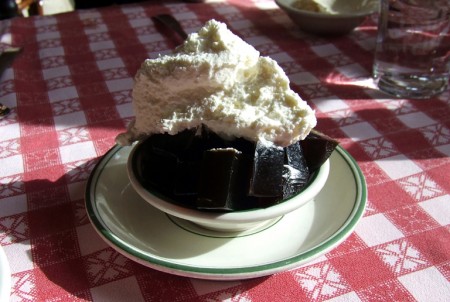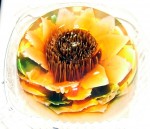Gelatin
United States, Great Britain and Asia
Oh, poor misunderstood gelatin! Anything resembling gelatin has been given the name “jello” by Americans (“jelly” by the British), although Jell-O is actually a trademark of one brand of commercially available gelatin. Gelatin in its pure form is clear and practically tasteless; it is typically manufactured by boiling down the bones, connective tissues, organs and the hides of cattle, pigs and/or horses in order to extract the collagen (sounds tasty, doesn’t it?). Surely you remember as a kid when mom boiled that ham for a New England boiled dinner, popping the remains into the fridge – when that door swung open the next day, voila! – gelatin. Serving just the gelatin became popular way back in the late 1800s, although it required the aforementioned cooking down process or buying dried gelatin sheets and purifying and reconstituting them, which quite frankly was a pain in the gluteus maximus. Commercially available powdered gelatin made dessert preparation easier because of two men – Peter Cooper who patented the process of powdering gelatin, and Charles Knox who created and marketed a pre-granulated gelatin. Pearle Wait (who bought Peter Cooper’s patent) added flavoring to the powdered gelatin in 1897 and began marketing it as Jell-O; Knox became known for his unflavored variety. To this day Jell-O (which was manufactured by General Foods) and Knox are both Kraft Foods brands, with Jell-O so popular that the governor of Utah declared it to be the state snack (take that, Illinois, with your stinkin’ popcorn).
Gelatin on its own hardly seems like a trippy food (at least to Americans and the British), but ingenuity has taken this simple food to a whole new level. Boston’s Durgin Park has been operating as a restaurant since the 1830s (named by John Durgin and Eldridge Park who bought it in 1827). Through the 1980s the restaurant had the reputation of being rude to the customers, which customers assumed was a gimmick much like Ed Debevic’s in Chicago or Dick’s Last Resort, but when I remarked to the waitress that she was actually quite polite, she stated that the former wait staff were “just plain grouchy”. The story goes that sometime during mid-1900s, frugal proprietor James Hallett got tired of seeing the day’s coffee being poured down the drain and hit upon the idea of creating a desert from it, namely “coffee jello.” The desert is served topped with real whipped cream, which adds just the right amount of sweetness (the gelatin and coffee combination is unsweetened). The coffee component tastes homemade using a good quality brew, and the black, shiny cubes topped with the frothy, white whipped cream makes it a sight to behold.
Jellied eels are a British specialty that dates back to 1700s London. Freshwater eels (traditionally right out of the Thames) are boiled with nutmeg, lemon juice and diced vegetables like onions and carrots, then cooled creating a gelatin in the same manner as with the pork or beef variety with the cooking process releasing the collagen. The cooked eels have a similar consistency and taste to herring (perhaps a bit firmer) with tiny brittle bones like sardines. Jellied eels are generally available at pie and mash shops in London’s East End, but I tried them at a small alleyway stand in Greenwich. The eel was served cold and delicious, requiring some deft tongue work (one of my hidden talents) to work the flesh off the bones. As long as I was there, I had a small cup of whelks with vinegar, which were chewy but flavorful, and pie (meat) and mash. I won’t spend much time on them since the article is about gelatin, and quite frankly the pie and mash were substandard; a fellow patron stated that the flat, soggy and chewy pie tasted like it was frozen and then microwaved. I’ll have proper pie and mash on my next visit to London.
The recently popular trend of artistic gelatin is producing deserts that look like flowers in Lucite but are completely edible. The Wilton School offers classes specific to this culinary art, which requires patience, concentration, and a variety of syringes, with the output almost too beautiful to eat. A friend has started producing these, bringing one to a recent party. The dish is a treat for multiple senses, especially since the multiple colors used have different complementary flavors that blend together perfectly. At the aforementioned party, we asked her to serve it for us as none of us wanted to be responsible for ruining her masterpiece.
Grass jelly is a special Asian treat that is included here even though it is not technically gelatin. It is traditionally made by boiling stalks of the mesona chinensis plant (a variety of mint, also called xiancao, sian-chháu, or leung fan cao) with potassium carbonate and some starch and then refrigerating. The result looks like a lighter version of Durgin Park’s coffee jello, with a refreshing taste similar to an unsweetened mint tea. It is sometimes served as a gelatinous drink by itself or mixed with soy or evaporated milk, although for me it makes a nice dessert after cramming my bowl filled with whatever is available at the local Mongolian BBQ.
The next time Aunt Millie brings out the Jell-O mold with embalmed fruit bits suspended in it, explain to her how gelatin is made and it may get you a bye at having to eat it. Just don’t expect a nice knitted tie at Christmas…
Durgin Park
340 Faneuil Hall Marketplace
Boston, MA 02109
GPS coordinates: 42°21’37.38″N 71°3’18.57″W
G. Kelly’s Eel and Pie
526 Roman Road
Bow, London, UK E3 5ES
GPS coordinates: 51°31’57.48″N 0°1’48.65″W






I’d really like to try jellied eels. Nice article :]
Thanks for the kind words. If you’ve enjoyed unagi at your local sushi bar you will probably enjoy jellied eel as well. In regards to gelatine, Jell-O snuck into last month’s article on Burns Night Supper cleverly hiding in the British desert, trifle…
Was not a fan of the coffee jello, yet I love coffee…
And if you like iced coffee, coffee jello would seem like a natural!
Where is the paragraph on jello-o shots? I know you can’t post the video to keep the site rated PG-13.
I’m thinking of doing an article on unique alcoholic beverages and their effects on writing a blog article – perhaps we should include Jell-O shots made from scorpion mescal or something…
Hi Val, nice job on your site. To all the fans for the 3d gelatin, I want to invite all of you visit my site, and get my latest designs in encapsulated 3d gelatin. Also I have an e-book at an affordable price.
Rafaela, I looked at your site and you have some beautiful designs – it’s a shame to ruin them by eating them! The thing that fascinates me about them is the variety of flavors used for each part of the flowers and how they taste together.
Mmmm…I love coffee gelatin! I must say, that I do prefer the ‘gourmet’ gelatins with less sugar and more flavor than packaged Jell-O….
I’m sure Durgin Park’s is simply coffee with the clear “unflavored” gelatine – makes you wonder what other concoctions one could come up with…
To be honest, the photo of the coffee jello at first did not look appealing to me. But your article was great in going through the history of gelatin and when you describe the whipping cream on top of the unsweetened jello, I had a change of heart. Maybe I’ll try it one day if I’m ever in Boston. As for Aunt Millie’s jell-o mold, not so much…
Peter, if you like the taste of coffee that’s half the battle – the gelatin used doesn’t really impart any taste of its own.